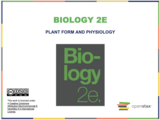
- Subject:
- Biology
- Life Science
- Material Type:
- Unit of Study
- Provider:
- Ohio Open Ed Collaborative


Solute concentrations across semi-permeable membranes influence the movement of water and solutes across the membrane. Osmoregulation and osmotic balance are important bodily functions, resulting in water and salt balance. Osmolarity is measured in units of milliequivalents or milliosmoles, both of which take into consideration the number of solute particles and the charge on them. Some organisms are osmoconformers in that they are isotonic with their environment. The kidneys are the main osmoregulatory organs in mammalian systems; they function to filter blood and maintain the osmolarity of body fluids. Many systems have evolved for excreting wastes that are simpler than the kidney and urinary systems of vertebrate animals. The simplest system is that of contractile vacuoles present in microorganisms. Flame cells and nephridia in worms perform excretory functions and maintain osmotic balance. Some insects have evolved Malpighian tubules to excrete wastes and maintain osmotic balance.


Virtually all life on Earth depends on Photosynthesis. Photosynthesis uses energy in sunlight to form organic molecules such as glucose. This transformation of light energy to chemical energy provides fuel for the metabolic processes in all organisms. Photosynthesis also produces oxygen required for aerobic cellular respiration. This chapter covers light energy as part of the electromagnetic spectrum, basic structures involved in photosynthesis and the metabolic pathways of photosynthesis divided into the light-dependent reactions and the Calvin cycle.


In scientific terms, phylogeny is the evolutionary history and relationship of an organism or group of organisms. A phylogeny describes the organism's relationships, such as from which organisms it may have evolved, or to which species it is most closely related. Scientists must collect accurate information that allows them to make evolutionary connections among organisms. It is a highly dynamic field of biology because phylogenetic modeling concepts are constantly changing as new information is collected. Over the last several decades, new research has challenged scientists’ ideas about how organisms are related.


Plants are as essential to human existence as land, water, and air. Without plants, our day-to-day lives would be impossible because without oxygen from photosynthesis, aerobic life cannot be sustained. From providing food and shelter to serving as a source of medicines, oils, perfumes, and industrial products, plants provide humans with numerous valuable resources. When you think of plants, most of the organisms that come to mind are vascular plants. These plants have tissues that conduct food and water, and they have seeds. Seed plants are divided into gymnosperms and angiosperms. Gymnosperms include the needle-leaved conifers susch spruce, fir, and pine. Their seeds are not enclosed by a fleshy fruit. Angiosperms, also called flowering plants, constitute the majority of seed plants. They include broadleaved trees (such as maple), vegetables (such as potatoes), grasses, and plants known for the beauty of their flowers (roses and daffodils, for example). In this module we will be exploring the different structures found within plants, the different physiological processes performed by plants, the different mechanisms of transport that occur within plants, and various response mechanisms used by plants.


Plants have evolved different reproductive strategies for the continuation of their species. Some plants reproduce sexually, and others asexually, in contrast to animal species, which rely almost exclusively on sexual reproduction. Plant sexual reproduction usually depends on pollinating agents, while asexual reproduction is independent of these agents. Flowers are often the showiest or most strongly scented part of plants. With their bright colors, fragrances, and interesting shapes and sizes, flowers attract insects, birds, and animals to serve their pollination needs. Other plants pollinate via wind or water; still others self-pollinate. This module will explore these ideas as well as their impacts on human ventures such as agriculture and horticulture.


Populations are dynamic entities. Populations consist all of the species living within a specific area, and populations fluctuate based on a number of factors: seasonal and yearly changes in the environment, natural disasters such as forest fires and volcanic eruptions, and competition for resources between and within species. Populations rarely, if ever, live in isolation from populations of other species. In most cases, numerous species share a habitat. The interactions between these populations play a major role in regulating population growth and abundance. All populations occupying the same habitat form a community: populations inhabiting a specific area at the same time. The number of species occupying the same habitat and their relative abundance is known as species diversity. Behavior is the change in activity of an organism in response to a stimulus. Behavioral biology is the study of the biological and evolutionary bases for such changes.


Carl Woese and his colleagues proposed that all life on Earth evolved along three lineages, called domains. Two of the three domains—Bacteria and Archaea—are prokaryotic. Prokaryotes were the first inhabitants on Earth, appearing 3.5 to 3.8 billion years ago. These organisms are abundant and ubiquitous; that is, they are present everywhere. In addition to inhabiting moderate environments, they are found in extreme conditions: from boiling springs to permanently frozen environments in Antarctica; from salty environments like the Dead Sea to environments under tremendous pressure, such as the depths of the ocean; and from areas without oxygen, such as a waste management plant, to radioactively contaminated regions, such as Chernobyl. Prokaryotes reside in the human digestive system and on the skin, are responsible for certain illnesses, and serve an important role in the preparation of many foods.


In more advanced animals, the senses are constantly at work, making the animal aware of stimuli—such as light, or sound, or the presence of a chemical substance in the external environment—and monitoring information about the organism’s internal environment. All bilaterally symmetric animals have a sensory system, and the development of any species’ sensory system has been driven by natural selection; thus, sensory systems differ among species according to the demands of their environments. The shark, unlike most fish predators, is electrosensitive—that is, sensitive to electrical fields produced by other animals in its environment. While it is helpful to this underwater predator, electrosensitivity is a sense not found in most land animals. In this chapter we will be exploring the different sensory systems found in animals.


Cucurbitaceae is a family of plants first cultivated in Mesoamerica, although several species are native to North America. The family includes many edible species, such as squash and pumpkin, as well as inedible gourds. In order to grow and develop into mature, fruit-bearing plants, many requirements must be met, and events must be coordinated. Seeds must germinate under the right conditions in the soil; therefore, temperature, moisture, and soil quality are important factors that play a role in germination and seedling development. Soil quality and climate are significant to plant distribution and growth. The young seedling will eventually grow into a mature plant, and the roots will absorb nutrients and water from the soil. At the same time, the aboveground parts of the plant will absorb carbon dioxide from the atmosphere and use energy from sunlight to produce organic compounds through photosynthesis. This module will explore the complex dynamics between plants and soils, and the adaptations that plants have evolved to make better use of nutritional resources.


The arctic fox is an example of a complex animal that has adapted to its environment and illustrates the relationships between an animal’s form and function. The structures of animals consist of primary tissues that make up more complex organs and organ systems. Homeostasis allows an animal to maintain a balance between its internal and external environments. This chapter will explore theses ideas as well as many more.